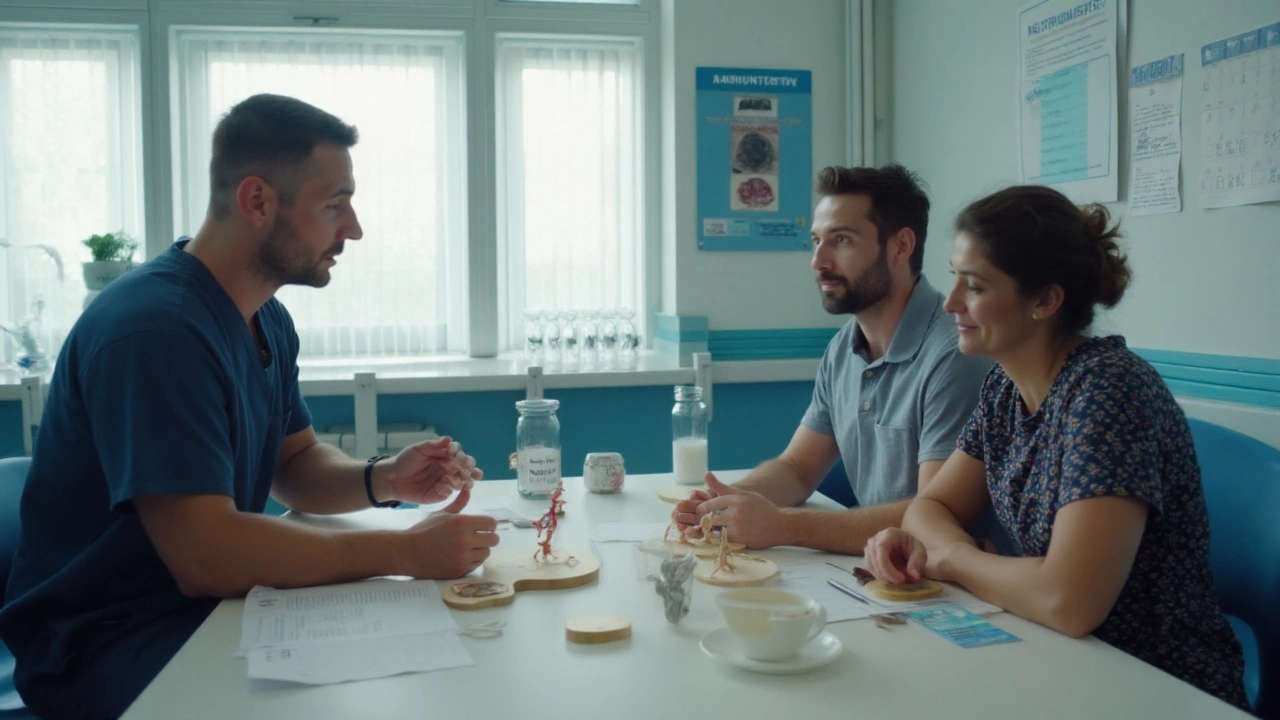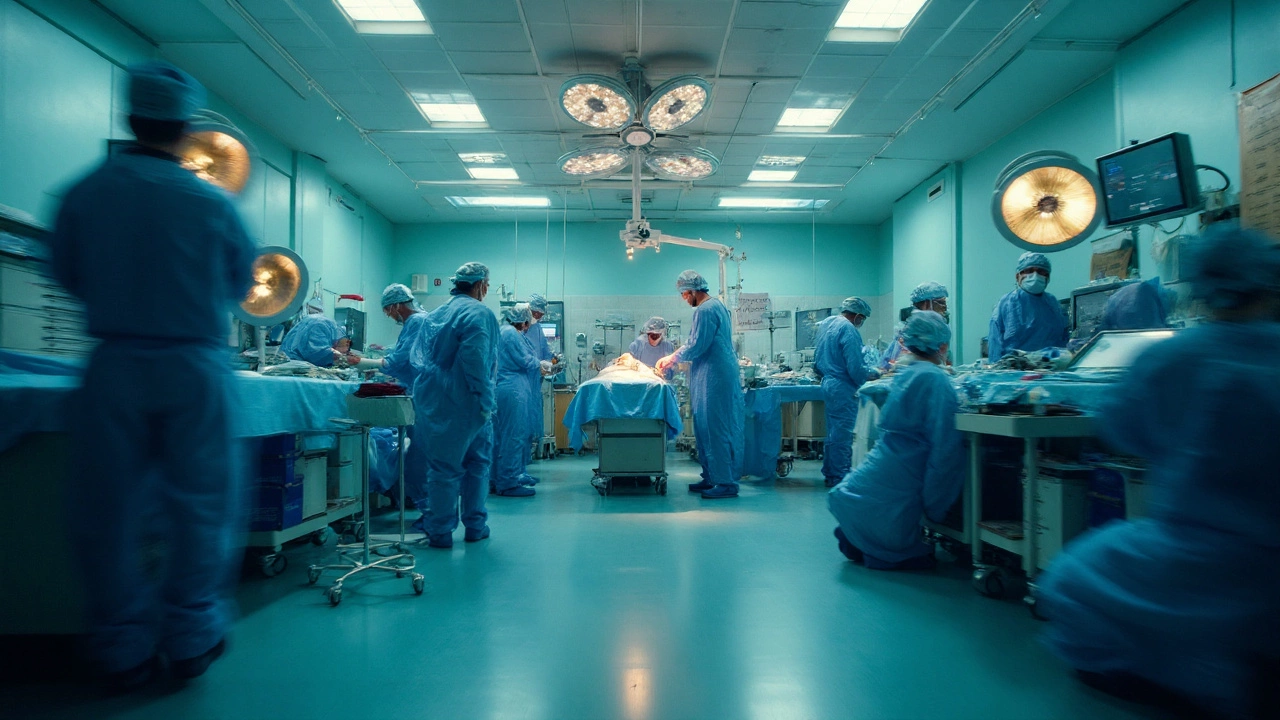 Sep, 12 2025
Sep, 12 2025
You want a straight answer: which surgeries count as “major,” and which five are the big ones people most often ask about? Here’s the short version you can act on today-what they are, why they’re done, the risks you should know about, and how long it takes to get your life back on track. No scare tactics. Just clarity.
Quick answer: the top five and why they’re on the list
TL;DR - When people ask about major surgeries, they usually mean operations that are complex, carry meaningful risk, and need a hospital stay and weeks (or months) of recovery. Using those criteria-plus global impact and frequency-the top five are:
- Coronary artery bypass graft (CABG): Open-heart surgery to restore blood flow to the heart. High impact, well-studied, life-extending for the right patients.
- Total hip replacement: Replaces a worn-out hip joint. Common, transformative for pain and mobility, with predictable recovery pathways.
- Caesarean section (C‑section): Major abdominal surgery to deliver a baby. Very common worldwide and lifesaving when indicated.
- Colorectal cancer resection (colectomy): Removes part of the colon to treat cancer. Curative intent in many cases.
- Kidney transplant: Replaces a failing kidney. Big surgery plus lifelong immunosuppression, but the quality-of-life payoff is huge.
Not every “big” operation made the cut. Brain surgery, spinal fusion, and liver transplant are major by any standard, but the five above balance complexity with how often real people encounter them.
Jobs you probably want to get done right now:
- Understand what counts as major surgery and why these five matter.
- See what actually happens before, during, and after-step by step.
- Compare risks, recovery times, and typical costs without the fluff.
- Use a simple checklist to prepare and reduce complications.
- Get quick answers to the questions everyone asks at 2 a.m.
What to expect before, during, and after major surgery (step‑by‑step)
Major surgery follows a pattern. Knowing it shrinks the unknowns.
- Pre‑assessment (1-4 weeks out)
- Tests: bloods, ECG, imaging, and sometimes a nasal swab for MRSA.
- Medication review: blood thinners, diabetes meds, and supplements get adjusted. Bring every bottle to your appointment.
- Prehab: gentle strength and walking can lower complication risk and speed recovery. Even 10-20 minutes a day matters.
- Smoking and alcohol: stopping 4+ weeks before surgery cuts infections and chest problems. Your anaesthesia team will back you on this.
- The day before
- Fasting as instructed (usually no solid food 6 hours before, clear fluids allowed up to 2 hours-but follow your hospital’s plan).
- Shower with antiseptic if advised. No shaving the surgical site-clippers at hospital do it right.
- Pack: slip-on shoes, phone charger, ID, meds list, and your CPAP if you use one.
- Day of surgery
- Anaesthesia review: final checks, consent, last questions.
- Operating theatre: time varies-see the cheat sheet below.
- Recovery room: monitors, oxygen, pain control. You’ll be groggy; that’s normal.
- First 24-72 hours
- Pain plan: scheduled meds beat “toughing it out.” Tell nurses before pain spikes.
- Early mobilisation: sitting up, leg pumps, short walks lower clots and pneumonia.
- Nutrition: return to eating as soon as your team okays it-protein supports healing.
- At home
- Wound care: keep it clean and dry; watch for redness, pus, fever.
- Activity: increase slowly. Short, frequent walks beat couch marathons.
- Follow-ups: show up, even if you “feel fine.” It’s how issues get caught early.
“Safe, affordable surgical and anesthesia care is an essential part of universal health coverage.” - World Health Organization
For safety basics, anaesthesia colleges and surgical colleges (ANZCA in Australia/NZ, Royal College of Surgeons in the UK, American College of Surgeons in the US) publish clear patient guides. Your team’s advice beats anything you read online-use this as a compass, not a prescription.

Deep dive: how each surgery works, risks, and recovery
1) Coronary artery bypass graft (CABG)
Why it’s done: To bypass blocked coronary arteries and improve blood flow to the heart, reducing angina and heart attack risk.
How it’s done: Surgeons graft a vein (often from the leg) or an artery (often the internal mammary) to detour around blockages. Many cases use a heart-lung machine; some are done “off-pump.”
Time in theatre: 3-6 hours depending on number of grafts.
Hospital stay: Typically 5-7 days; ICU for the first night or two.
Risks to know: Bleeding, arrhythmias (like atrial fibrillation), infection, lung issues, stroke (low but not zero), kidney strain. Risk rises with age and other conditions like diabetes or COPD.
Recovery: 6-12 weeks for core healing; cardiac rehab starts within days and continues for weeks. Most people return to desk work in 6-8 weeks; heavy labor takes longer.
Impact: For the right patients, CABG improves symptoms and survival compared with medicines alone. Cardiac societies (e.g., American Heart Association) support it for multivessel disease and left main disease after heart team review.
2) Total hip replacement
Why it’s done: To relieve severe arthritis pain and restore movement when injections, physio, and meds no longer cut it.
How it’s done: The damaged ball-and-socket are replaced with metal, ceramic, and/or plastic components. Approaches (posterior, lateral, anterior) vary by surgeon and patient.
Time in theatre: 60-120 minutes.
Hospital stay: 1-3 days; “same-day” discharge is growing in low-risk patients with good support at home.
Risks to know: Blood clots, infection, dislocation, leg length difference, implant wear. Enhanced recovery protocols reduce many of these.
Recovery: Walking with aids day 1; most drive by 3-6 weeks; near-full function by 3 months. High-impact sports are limited; low-impact is encouraged.
Impact: Hip replacement is one of the most successful surgeries for quality-of-life gain. National joint registries (UK, Australia/NZ) show 90%+ implants last 15-20 years in many patients.
3) Caesarean section (C‑section)
Why it’s done: To deliver a baby safely when vaginal birth isn’t safe (placenta previa, fetal distress, breech) or by maternal choice after informed discussion.
How it’s done: A lower abdominal incision and uterine incision deliver the baby. Usually spinal anaesthesia, so you’re awake and pain-free.
Time in theatre: 30-90 minutes (the baby is often out in minutes; most time goes to careful closure).
Hospital stay: 2-4 days depending on country and recovery speed.
Risks to know: Infection, bleeding, clots, and in future pregnancies, placenta accreta risk increases with each prior C‑section. Babies can have transient breathing issues.
Recovery: 4-6 weeks of no heavy lifting; scar tenderness improves over months. Good pain control helps bonding and breastfeeding.
Impact: C‑section is major abdominal surgery and lifesaving when needed. WHO advises against non‑medically indicated C‑sections before 39 weeks.
4) Colorectal cancer resection (colectomy)
Why it’s done: To remove a colon segment containing cancer, often with lymph nodes, aiming for cure. Sometimes paired with chemotherapy.
How it’s done: Laparoscopic (keyhole) or open surgery removes the diseased section; the bowel ends are rejoined (anastomosis). A temporary stoma is used in some cases to protect the join.
Time in theatre: 2-4 hours; longer if open surgery or complex anatomy.
Hospital stay: 3-7 days, shorter with enhanced recovery pathways.
Risks to know: Leak at the anastomosis, infection, ileus (bowel “sleepiness”), bleeding, clots. Nutritional status matters-protein and iron counts are not small details.
Recovery: Gradual energy return over 4-8 weeks. Walking, breathing exercises, and a fibre‑aware diet (guided by your team) help.
Impact: Early‑stage cancers can be cured with surgery alone. For stage III, surgery plus chemotherapy is standard in many guidelines (e.g., National Comprehensive Cancer Network; NHS guidance).
5) Kidney transplant
Why it’s done: To replace end‑stage kidney disease with a working kidney-from a deceased donor or a living donor.
How it’s done: The new kidney is placed in the lower abdomen and connected to blood vessels and the bladder; your own kidneys usually stay.
Time in theatre: 2-4 hours.
Hospital stay: 4-7 days if recovery is smooth.
Risks to know: Rejection, infection (immunosuppressants raise risk), blood clots, delayed graft function. Long‑term care is a partnership between you and your transplant team.
Recovery: Many people feel dramatically better in days if the kidney “wakes up” quickly. Back to desk work in 4-6 weeks; more if the job is physical.
Impact: Compared with dialysis, transplant improves survival and quality of life. National transplant bodies (e.g., Organ Donation New Zealand, NHS Blood and Transplant, UNOS) publish transparent outcomes by centre.
Cheat sheet: compare times, risks, and typical costs (+ prep checklist)
Numbers vary by hospital, country, and your health. These are ballpark figures to frame the conversation with your team.
| Surgery | Time in theatre | Hospital stay | Common risks | Back to daily life | Typical private cost (2025) |
|---|---|---|---|---|---|
| CABG | 3-6 hrs | 5-7 days (ICU 1-2) | Arrhythmia, bleeding, lung issues | 6-12 weeks | US: $75k-$200k; UK: NHS covered; NZ: public system; private rare |
| Hip replacement | 1-2 hrs | 1-3 days | Clots, infection, dislocation | 3-6 weeks light duties | US: $30k-$50k; UK self‑pay: £9k-£15k; NZ private: NZ$20k-$35k |
| C‑section | 0.5-1.5 hrs | 2-4 days | Infection, bleeding, clots | 4-6 weeks | US: $15k-$30k; UK: NHS covered; NZ: public; private obstetric fees vary |
| Colectomy | 2-4 hrs | 3-7 days | Leak, infection, ileus | 4-8 weeks | US: $30k-$70k; UK self‑pay: £12k-£20k; NZ: public; private varies |
| Kidney transplant | 2-4 hrs | 4-7 days | Rejection, infection | 4-6 weeks (desk work) | US: ~$400k first‑year bundled; UK/NZ: public systems |
Sources for context: national surgical registries and payer datasets (e.g., American Hospital Association, NHS Reference Costs, New Zealand Te Whatu Ora), plus guidance from the American Heart Association, Royal College of Surgeons, and transplant authorities. Always confirm your personal estimate with your hospital.
Prep checklist to cut risk
- Know your meds: write down dose and timing; ask which to stop and when.
- Protein target: aim for 1.2-1.5 g/kg/day for 1-2 weeks pre‑op if safe for you (ask if you have kidney disease).
- Walking plan: 20-30 minutes a day, broken into chunks if needed.
- Home setup: waist‑high items, night light, non‑slip bath mat, raised toilet seat for hip surgery.
- Support person: name one. Share the plan, rides, and medication schedule.
- Questions list: what’s my specific risk? when can I shower? who do I call at 10 p.m.?
Red flags after discharge (call your team)
- Chest pain, shortness of breath, calf pain/swelling-think clots.
- Fever > 38°C, wound redness spreading, foul drainage.
- Severe, new abdominal pain or distension after bowel surgery.
- No urine output for 8+ hours after transplant or sudden drop from your baseline.
- Confusion, weakness on one side, or slurred speech-emergency assessment.

Mini‑FAQ and next steps
Is cataract surgery a “major” operation? It’s incredibly common, but typically classified as minor or intermediate. Short, low risk, usually day surgery. Not in this top five.
What’s the death risk with major surgery? It depends on your health and the procedure. In high‑income countries, low‑risk elective surgeries have very low mortality; complex operations in frail patients have higher risk. Your anaesthetist can give a personalised estimate using validated scores (ASA class, POSSUM, NSQIP) and your lab results.
How can I reduce complications? Don’t smoke, move early, eat protein, take prescribed blood thinners, use your incentive spirometer, and keep pain controlled enough to breathe deep and walk. These simple habits move the needle.
Will I need ICU? CABG usually, transplants sometimes, and others only if complications or severe comorbidities. ICU is routine for some surgeries; it doesn’t always mean something went wrong.
Public vs private-what changes? In countries like New Zealand and the UK, public systems cover most major surgeries. Private can shorten waits and give surgeon choice, but you still want a hospital that does high volumes of your procedure-volume links to outcomes across multiple studies and registries.
Can I travel for surgery? Possible, but be careful. Continuity of care matters, especially for transplants and cancer surgery. Check surgeon/hospital volumes, accreditation, and plan follow‑up at home before you book flights.
Next steps if surgery is on your calendar
- Ask your surgeon for your personalised risk and your expected length of stay. Write it down.
- Request an “enhanced recovery after surgery” (ERAS) plan-nutrition, pain, mobilisation, and nausea protocols in one page.
- Sort finances early: confirm coverage with your insurer; ask for a written estimate (surgeon, anaesthesia, hospital, devices).
- Book prehab sessions with physio if you’re getting a hip replacement or recovering from heart surgery.
- In New Zealand: your GP and Te Whatu Ora pathway will coordinate public care; private hospitals can provide quotes for hip/C‑section self‑pay if applicable. Ask for itemised costs and implant details.
Troubleshooting common snags
- My surgery got delayed. Keep up prehab, maintain protein, and ask for a new date plus a plan to manage symptoms while you wait.
- I’m scared of anaesthesia. Tell your anaesthetist. They can walk you through monitoring, nausea prevention, and pain options-knowledge lowers anxiety.
- Pain meds make me nauseous. Ask about multimodal pain: paracetamol/acetaminophen, anti‑inflammatories (if safe), nerve blocks, and anti‑nausea meds.
- I live alone. Organise a friend or a paid carer for the first 48-72 hours. Consider hospital‑to‑home services; social workers can help.
One last nudge: high‑volume centres and teams with clear ERAS protocols consistently post better outcomes. That’s not hype-that’s decades of audit data from surgical colleges and national registries. Ask the awkward questions. Good teams welcome them.
